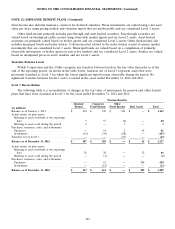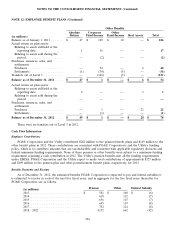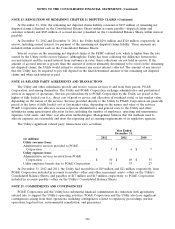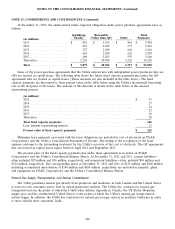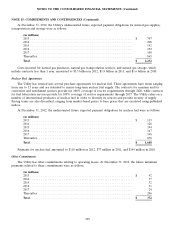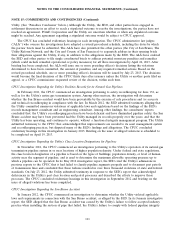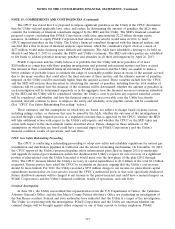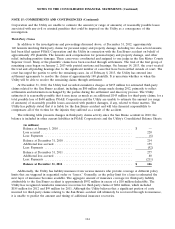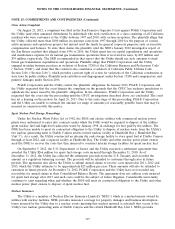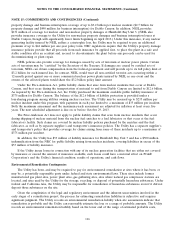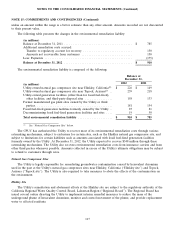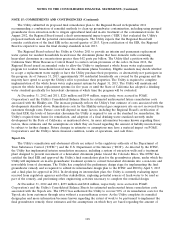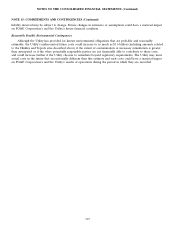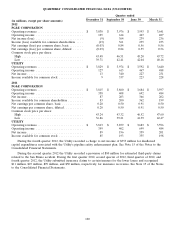PG&E 2012 Annual Report Download - page 116
Download and view the complete annual report
Please find page 116 of the 2012 PG&E annual report below. You can navigate through the pages in the report by either clicking on the pages listed below, or by using the keyword search tool below to find specific information within the annual report.NOTES TO THE CONSOLIDATED FINANCIAL STATEMENTS (Continued)
NOTE 15: COMMITMENTS AND CONTINGENCIES (Continued)
management requirements, the Utility’s inadequate record keeping practices, deficiencies in the Utility’s data
collection and reporting system, the Utility’s inadequate procedures to handle emergencies and abnormal conditions,
the Utility’s deficient emergency response actions after the incident, and a systemic failure of the Utility’s corporate
culture that emphasized profits over safety. The CPUC stated that the scope of the investigation will include all past
operations, practices and other events or courses of conduct that could have led to or contributed to the San Bruno
accident, as well as, the Utility’s compliance with CPUC orders and resolutions issued since the date of the San
Bruno accident.
The Utility submitted testimony to the CPUC that acknowledged its liability for the San Bruno accident and,
based on testimony from an expert witness, stated that the likely root cause of the pipeline rupture was: (1) a missing
interior weld on the pipe; (2) a ductile tear on the pipe likely caused by a hydrostatic test performed in 1956 at too
low a pressure to cause the defective weld to fail; and (3) a fatigue crack on the pipe that grew over time. However,
the Utility stated that many of the findings identified in the SED’s reports are not deficiencies, or are much less
severe than alleged, and do not constitute violations of applicable laws and regulations. The CPUC concluded
evidentiary hearings in this investigation in January 2013. Briefing on the issue of alleged violations is scheduled to
be completed on April 12, 2013.
Other Potential Enforcement Matters
California gas corporations are required to provide notice to the CPUC of any self-identified or self-corrected
violations of certain state and federal regulations related to the safety of natural gas facilities and the corporations’
natural gas operating practices. The CPUC has authorized the SED to issue citations and impose penalties based on
self-reported violations. In April 2012, the CPUC affirmed a $17 million penalty that had been imposed by the SED
based on the Utility’s self-report that it failed to conduct periodic leak surveys because it had not included 16 gas
distribution maps in its leak survey schedule. (The Utility has paid the penalty and completed all of the missed leak
surveys.) As of December 31, 2012, the Utility has submitted 34 self-reports with the CPUC, plus additional
follow-up reports. The SED has not yet taken formal action with respect to the Utility’s other self-reports. The SED
may issue additional citations and impose penalties on the Utility associated with these or future reports that the
Utility may file. (See ‘‘Penalties Conclusion’’ below.)
In addition, in July 2012, the Utility reported to the CPUC that it had discovered that its access to some
pipelines has been limited by vegetation overgrowth or building structures that encroach upon some of the Utility’s
gas pipeline rights-of-way. The Utility is undertaking a system-wide effort to identify and remove encroachments
from its pipeline rights-of-way over a multi-year period. PG&E Corporation and the Utility are uncertain how this
matter will affect the above investigative proceedings related to natural gas operations, or whether additional
proceedings or investigations will be commenced that could result in regulatory orders or the imposition of penalties
on the Utility.
Penalties Conclusion
The CPUC can impose penalties of up to $20,000 per day, per violation. (For violations that are considered to
have occurred on or after January 1, 2012, the statutory penalty has increased to a maximum of $50,000 per day, per
violation.) The CPUC has wide discretion to determine the amount of penalties based on the totality of the
circumstances, including such factors as the gravity of the violations; the type of harm caused by the violations and
the number of persons affected; and the good faith of the entity charged in attempting to achieve compliance, after
notification of a violation. The CPUC is also required to consider the appropriateness of the amount of the penalty
to the size of the entity charged. The CPUC has historically exercised this wide discretion in determining penalties.
The CPUC’s delegation of enforcement authority to the SED allows the SED to use these factors in exercising
discretion to determine the number of violations, but the SED is required to impose the maximum statutory penalty
for each separate violation that the SED finds.
112



